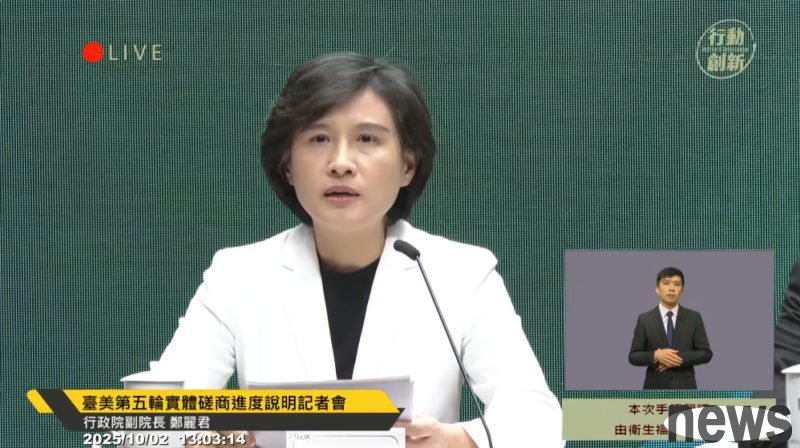Regarding Taiwan-U.S. tariff negotiations, Vice President of the Executive Yuan Cheng Li-jun stated on the 2nd that unlike Japan, South Korea and the European Union, we advocate a model of expanding investment and plan to use industrial investment p...

Regarding Taiwan-U.S. tariff negotiations, Vice President of the Executive Yuan Cheng Li-jun stated on the 2nd that unlike Japan, South Korea and the European Union, we advocate a model of expanding investment and plan to use industrial investment planning and government support measures to achieve an industrial cluster for Taiwan-U.S. cooperation and joint development, and strive for a favorable investment environment and conditions from the United States. The "Taiwan Model".
The Executive Yuan held a "press conference on the progress of the fifth round of Taiwan-US substantive consultations" today. Cheng Lijun said that our negotiating team will conduct the fifth round of substantive consultations with the United States from September 25 to 29, Washington time, including talks with US representative Jamieson Lee Greer and two meetings with US Commerce Secretary Howard Lutnick and his team. We hope to reduce the temporary tax rate by 20%, not overlay the original tax rate, supply chain cooperation and Section 232 concessions; the United States hopes that local chip manufacturing capabilities can meet local needs in the United States, and hopes that friendly countries will participate together. This is the strategic goal of the United States, but my country also has its own industrial goals, and will help companies expand their presence in the United States based on the overall goal of "remaining in Taiwan and developing a global presence."
Zheng Lijun also said that unlike Japan, South Korea and the European Union, Taiwan's investment in the United States will adopt enterprise autonomy, the government will provide financial credit guarantees, and strive for a favorable investment environment from the United States, such as land, water and electricity, in order to favorably shape the semiconductor ecological chain in the United States; we are willing to rely on Taiwan's experience and through the Taiwan-US G TO G (government-to-government) cooperation to help build industrial clusters in the United States and reduce business costs and investment risks. Therefore, this is not to move Taiwan’s science parks there, but to rely on the experience of Taiwan’s science parks to create an environment conducive to the formation of industrial clusters in the United States; and the United States views this model positively.
Regarding the 50/50 talk about Taiwan-US chips, Zheng Lijun emphasized that our team has never made a 50/50 commitment. This is different from the direction of the supply chain cooperation plan currently being discussed by Taiwan and the United States, and we will not agree to such conditions in the future. Taiwan's semiconductor ecosystem is the result of Taiwan's gradual development over decades.
Further reading: Zheng Lijun: I have never made a 50/50 promise for chips, nor will I agree to this condition. Chip manufacturing is 50/50, experts: The definition of silicon shield has changed to the common resilience of Taiwan and the United States The U.S. Secretary of Commerce does not agree with Taiwan’s view on silicon shield, saying that the semiconductor production capacity between Taiwan and the United States should be split 50-50. Trump urges U.S. chip production, industry: time-consuming, vast territory, difficult to establish a settlement